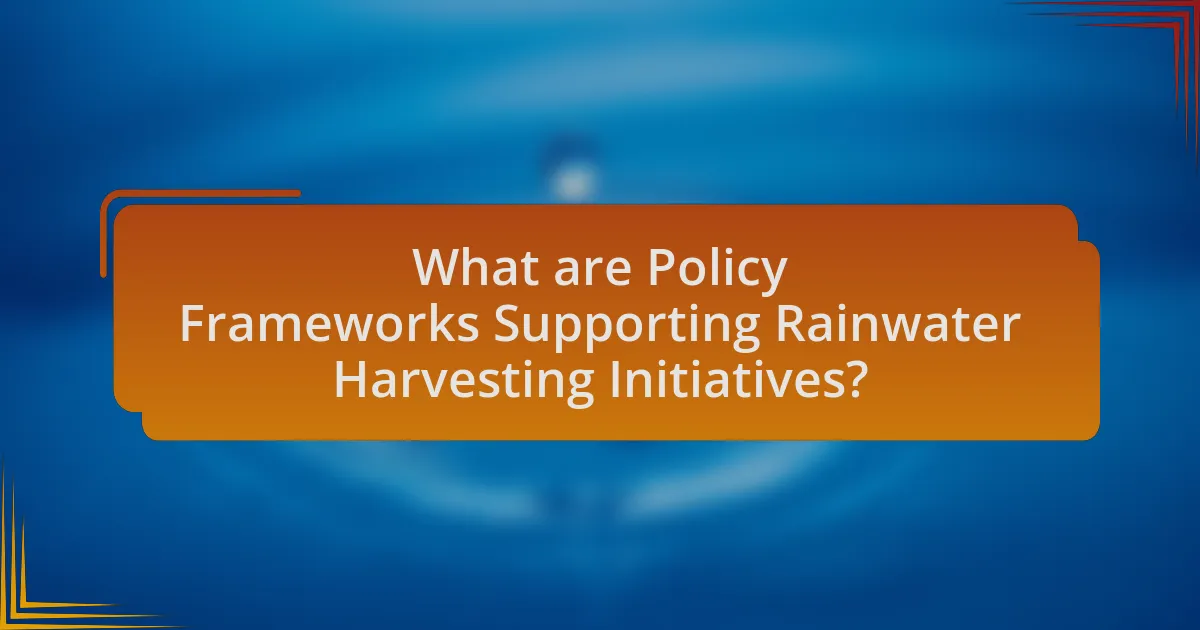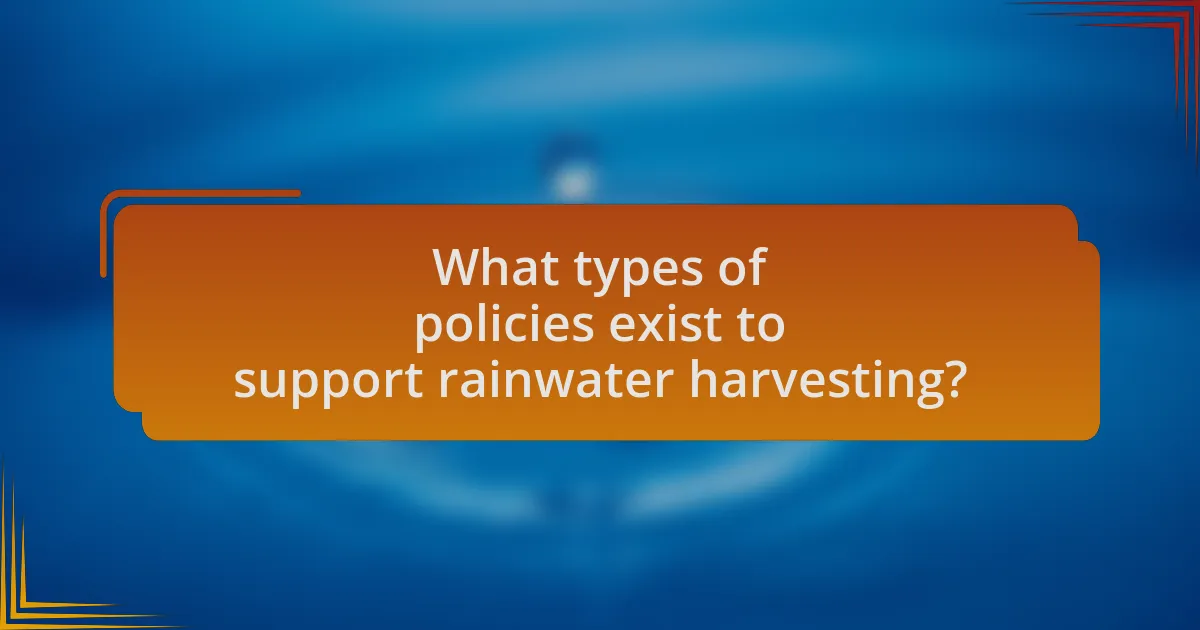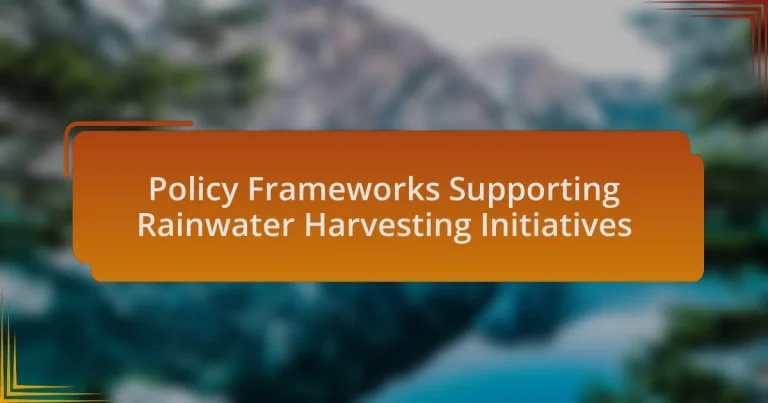Policy frameworks supporting rainwater harvesting initiatives encompass regulations, guidelines, and incentives established by governments and organizations to encourage the collection and utilization of rainwater. These frameworks include building codes, financial incentives such as tax rebates and grants, and educational programs aimed at raising awareness of the benefits of rainwater harvesting. Effective policy frameworks consist of clear objectives, stakeholder engagement, regulatory mechanisms, and monitoring processes that collectively enhance the adoption of rainwater harvesting practices. The article examines the influence of these frameworks on implementation, the challenges faced without supportive policies, and the role of financial incentives and community engagement in promoting sustainable water management.
What are Policy Frameworks Supporting Rainwater Harvesting Initiatives?

Policy frameworks supporting rainwater harvesting initiatives include regulations, guidelines, and incentives established by governments and organizations to promote the collection and use of rainwater. These frameworks often encompass building codes that require or encourage rainwater harvesting systems in new constructions, financial incentives such as tax rebates or grants for installation, and educational programs to raise awareness about the benefits of rainwater harvesting. For instance, the United States Environmental Protection Agency (EPA) has developed guidelines that encourage local governments to adopt rainwater harvesting practices as part of their stormwater management strategies, highlighting the importance of sustainable water management in urban planning.
How do these policy frameworks influence rainwater harvesting practices?
Policy frameworks significantly influence rainwater harvesting practices by establishing regulations, incentives, and guidelines that promote or hinder implementation. For instance, government policies that provide financial incentives, such as tax rebates or grants for rainwater harvesting systems, encourage individuals and businesses to adopt these practices. Additionally, regulations that mandate the integration of rainwater harvesting in new construction projects can lead to increased adoption rates. Evidence from various regions shows that areas with supportive policy frameworks experience higher rates of rainwater harvesting implementation, as seen in countries like Australia and India, where specific legislation has been enacted to facilitate these systems.
What are the key components of effective policy frameworks?
The key components of effective policy frameworks include clear objectives, stakeholder engagement, regulatory mechanisms, and monitoring and evaluation processes. Clear objectives provide direction and purpose, ensuring that policies are aligned with specific goals, such as promoting rainwater harvesting. Stakeholder engagement involves collaboration with communities, government agencies, and private sectors to ensure diverse perspectives and needs are addressed. Regulatory mechanisms establish guidelines and standards that govern practices, ensuring compliance and effectiveness. Monitoring and evaluation processes are essential for assessing the impact of policies and making necessary adjustments based on data and feedback, thereby enhancing the overall effectiveness of the framework.
How do these components interact to promote rainwater harvesting?
Components such as legislation, incentives, and community engagement interact to promote rainwater harvesting by creating a supportive environment for its implementation. Legislation establishes the legal framework that mandates or encourages rainwater harvesting practices, ensuring compliance and standardization. Incentives, such as tax breaks or subsidies, provide financial motivation for individuals and organizations to invest in rainwater harvesting systems. Community engagement fosters awareness and education, leading to increased public participation and acceptance of rainwater harvesting initiatives. Together, these components create a synergistic effect that enhances the adoption and effectiveness of rainwater harvesting practices, ultimately contributing to sustainable water management.
Why are policy frameworks essential for rainwater harvesting initiatives?
Policy frameworks are essential for rainwater harvesting initiatives because they provide a structured approach to regulation, funding, and implementation. These frameworks establish clear guidelines that ensure the effective management of water resources, promote sustainable practices, and encourage community participation. For instance, countries with established policies, such as India, have seen significant increases in rainwater harvesting due to government incentives and regulatory support, leading to improved water security and reduced dependency on groundwater.
What challenges do rainwater harvesting initiatives face without supportive policies?
Rainwater harvesting initiatives face significant challenges without supportive policies, including lack of funding, inadequate infrastructure, and limited public awareness. Without government backing, these initiatives often struggle to secure financial resources necessary for implementation and maintenance. Additionally, the absence of regulatory frameworks can lead to poor infrastructure development, resulting in inefficient systems that fail to capture and store rainwater effectively. Furthermore, without policies promoting education and outreach, communities may remain unaware of the benefits and methods of rainwater harvesting, hindering participation and adoption. These factors collectively impede the success and sustainability of rainwater harvesting efforts.
How do policies enhance community engagement in rainwater harvesting?
Policies enhance community engagement in rainwater harvesting by providing structured guidelines, incentives, and support mechanisms that encourage participation. For instance, policies can establish financial incentives such as tax rebates or grants for households and communities that implement rainwater harvesting systems, thereby motivating individuals to engage in these practices. Additionally, regulations can mandate the inclusion of rainwater harvesting in new construction projects, fostering a culture of sustainability within communities. Evidence from various regions shows that communities with supportive policies experience higher rates of participation in rainwater harvesting initiatives, leading to improved water management and environmental benefits.
What types of policies exist to support rainwater harvesting?

Various policies exist to support rainwater harvesting, including regulatory frameworks, financial incentives, and educational programs. Regulatory frameworks often mandate the installation of rainwater harvesting systems in new constructions, while financial incentives may include tax rebates or grants for homeowners who implement such systems. Educational programs aim to raise awareness about the benefits of rainwater harvesting and provide guidance on best practices. These policies collectively enhance the adoption of rainwater harvesting, contributing to sustainable water management and conservation efforts.
How do regulatory policies impact rainwater harvesting initiatives?
Regulatory policies significantly influence rainwater harvesting initiatives by establishing legal frameworks that either promote or hinder their implementation. For instance, policies that provide incentives such as tax breaks or grants encourage property owners to invest in rainwater harvesting systems, leading to increased adoption rates. Conversely, stringent regulations that impose high compliance costs or complex permitting processes can deter individuals and businesses from pursuing these initiatives. Evidence from various regions shows that areas with supportive regulatory environments, such as California’s SB 1253, which streamlines permitting for rainwater systems, experience higher rates of installation and public engagement in sustainable water practices.
What are the common regulatory measures implemented?
Common regulatory measures implemented for rainwater harvesting initiatives include building codes, permits, and incentives. Building codes often mandate the installation of rainwater harvesting systems in new constructions, ensuring compliance with safety and environmental standards. Permits are typically required to regulate the installation and use of these systems, ensuring they meet local regulations. Additionally, financial incentives such as tax credits or rebates are provided to encourage property owners to adopt rainwater harvesting practices, promoting sustainable water management. These measures collectively support the effective implementation of rainwater harvesting initiatives.
How do these measures ensure compliance and effectiveness?
These measures ensure compliance and effectiveness by establishing clear guidelines and standards for rainwater harvesting practices. Regulatory frameworks mandate specific design, maintenance, and operational protocols that must be followed, which helps to standardize practices across different regions. For instance, jurisdictions that implement mandatory permits for rainwater harvesting systems can monitor compliance through inspections and reporting requirements, thereby ensuring that systems meet safety and environmental standards. Additionally, financial incentives, such as tax rebates or grants for compliant systems, encourage adherence to these regulations, further enhancing effectiveness in achieving water conservation goals.
What role do financial incentives play in policy frameworks?
Financial incentives are crucial in policy frameworks as they encourage the adoption and implementation of desired behaviors and practices. In the context of rainwater harvesting initiatives, these incentives can take the form of subsidies, tax breaks, or grants that reduce the financial burden on individuals and organizations. For instance, a study by the World Bank in 2020 highlighted that countries offering financial incentives for rainwater harvesting saw a 30% increase in system installations compared to those without such incentives. This demonstrates that financial incentives effectively drive participation and investment in sustainable practices, thereby enhancing the overall success of policy frameworks aimed at promoting rainwater harvesting.
What types of financial incentives are commonly offered?
Commonly offered financial incentives for rainwater harvesting initiatives include tax credits, grants, rebates, and low-interest loans. Tax credits reduce the amount of tax owed, encouraging investment in rainwater systems. Grants provide direct funding to cover installation costs, while rebates offer partial refunds after purchase. Low-interest loans make financing more accessible, allowing for manageable repayment terms. These incentives are designed to promote sustainable water management practices and have been implemented in various regions to support environmental goals.
How do these incentives affect the adoption of rainwater harvesting systems?
Incentives significantly enhance the adoption of rainwater harvesting systems by reducing financial barriers and promoting awareness. Financial incentives, such as tax credits, rebates, and grants, lower the initial investment required for installation, making these systems more accessible to homeowners and businesses. For instance, a study by the American Rainwater Catchment Systems Association found that regions offering financial incentives saw a 30% increase in system installations compared to those without such support. Additionally, educational incentives, including workshops and informational campaigns, raise awareness about the benefits of rainwater harvesting, further driving adoption rates.
How can stakeholders effectively implement these policy frameworks?

Stakeholders can effectively implement policy frameworks for rainwater harvesting initiatives by establishing clear guidelines, engaging in community education, and fostering collaboration among various sectors. Clear guidelines provide a structured approach for stakeholders to follow, ensuring consistency and compliance with regulations. Community education raises awareness about the benefits and techniques of rainwater harvesting, which can increase public support and participation. Collaboration among government agencies, non-profits, and private sectors enhances resource sharing and expertise, leading to more successful implementation. For instance, the United Nations Environment Programme emphasizes the importance of multi-stakeholder partnerships in achieving sustainable water management practices, which supports the effectiveness of these frameworks.
What strategies can be employed to promote policy awareness?
To promote policy awareness regarding rainwater harvesting initiatives, targeted communication strategies should be employed. These strategies include public education campaigns that utilize social media, workshops, and community events to inform stakeholders about the benefits and regulations of rainwater harvesting. Research indicates that community engagement increases awareness and support for environmental policies, as seen in studies conducted by the Environmental Protection Agency, which found that informed communities are more likely to adopt sustainable practices. Additionally, collaboration with local organizations can amplify outreach efforts, ensuring that diverse audiences receive consistent and accurate information about policy frameworks supporting rainwater harvesting.
How can education and outreach programs enhance understanding of policies?
Education and outreach programs enhance understanding of policies by providing clear information and context about the regulations and practices involved. These programs facilitate knowledge transfer through workshops, seminars, and informational materials that break down complex policy language into accessible content. For instance, studies have shown that communities engaged in educational initiatives related to environmental policies, such as rainwater harvesting, demonstrate a higher compliance rate and better implementation of these practices. This is evidenced by a report from the Environmental Protection Agency, which found that targeted outreach efforts increased community participation in water conservation programs by 40%.
What role do local governments play in policy implementation?
Local governments play a crucial role in policy implementation by translating broader policies into actionable programs at the community level. They are responsible for enforcing regulations, allocating resources, and ensuring compliance with state and federal guidelines. For instance, local governments often develop specific ordinances and incentives to promote rainwater harvesting, such as tax rebates or grants for residents who install rainwater collection systems. This localized approach allows for tailored solutions that address the unique environmental and social needs of the community, thereby enhancing the effectiveness of rainwater harvesting initiatives.
What best practices should be followed for successful policy implementation?
Successful policy implementation for rainwater harvesting initiatives requires clear objectives, stakeholder engagement, and effective monitoring. Clear objectives ensure that all parties understand the goals and expected outcomes, which facilitates alignment and focus. Engaging stakeholders, including local communities, government agencies, and environmental organizations, fosters collaboration and support, increasing the likelihood of successful adoption. Effective monitoring and evaluation mechanisms allow for the assessment of progress and the identification of areas for improvement, ensuring that the policy remains relevant and effective over time. These practices are supported by case studies showing that policies with defined goals and active stakeholder participation lead to higher success rates in environmental initiatives.
How can stakeholder collaboration improve policy outcomes?
Stakeholder collaboration can significantly improve policy outcomes by fostering diverse perspectives and expertise, which leads to more comprehensive and effective policies. When various stakeholders, including government agencies, community organizations, and private sector representatives, work together, they can identify shared goals and address potential challenges more effectively. For instance, a study by the World Resources Institute found that collaborative governance in water management resulted in better resource allocation and increased community engagement, ultimately enhancing policy effectiveness. This collaborative approach ensures that policies are not only technically sound but also socially acceptable, leading to higher rates of implementation and success in initiatives like rainwater harvesting.
What monitoring and evaluation methods are effective for assessing policy impact?
Effective monitoring and evaluation methods for assessing policy impact include quantitative methods such as surveys and statistical analysis, as well as qualitative methods like interviews and focus groups. Quantitative methods provide measurable data that can demonstrate changes in outcomes, while qualitative methods offer insights into stakeholder experiences and perceptions regarding the policy. For instance, a study by the World Bank on water management policies highlighted the importance of combining both methods to capture a comprehensive view of policy effectiveness, showing that policies promoting rainwater harvesting led to a 30% increase in water availability in targeted regions. This dual approach ensures that both numerical data and personal narratives inform the evaluation process, leading to more robust conclusions about policy impact.
What are the common challenges in implementing policy frameworks for rainwater harvesting?
Common challenges in implementing policy frameworks for rainwater harvesting include lack of awareness, insufficient funding, regulatory hurdles, and inadequate infrastructure. Lack of awareness among stakeholders can lead to low participation rates, while insufficient funding limits the development and maintenance of harvesting systems. Regulatory hurdles often arise from complex legal frameworks that do not support rainwater harvesting initiatives, and inadequate infrastructure can hinder the effective collection and storage of rainwater. These challenges are documented in various studies, including the “Rainwater Harvesting: A Sustainable Water Management Strategy” report by the United Nations, which highlights the need for comprehensive policies to address these barriers.
How can these challenges be addressed to improve policy effectiveness?
To improve policy effectiveness in rainwater harvesting initiatives, challenges can be addressed through comprehensive stakeholder engagement and data-driven decision-making. Engaging local communities, government agencies, and private sectors ensures that policies reflect the needs and realities of those affected, fostering collaboration and support. Data-driven decision-making, supported by empirical research, allows policymakers to identify best practices and measure the impact of initiatives, leading to informed adjustments and enhancements. For instance, studies have shown that regions with active community involvement in policy formulation experience higher compliance and success rates in implementation, as evidenced by the success of rainwater harvesting programs in places like Australia and India.
What lessons can be learned from successful case studies?
Successful case studies in rainwater harvesting initiatives demonstrate the importance of comprehensive policy frameworks that integrate community engagement, technical support, and financial incentives. These frameworks often lead to increased adoption rates and sustainability of rainwater harvesting systems. For instance, the case study of the Indian state of Tamil Nadu shows that mandatory rainwater harvesting in new buildings resulted in a significant increase in water conservation practices, with over 50% of new constructions implementing such systems within a few years. This highlights that effective policies can drive behavioral change and enhance resource management.
What practical tips can enhance the effectiveness of rainwater harvesting policies?
To enhance the effectiveness of rainwater harvesting policies, governments should implement clear regulations and incentives that promote installation and maintenance. Establishing guidelines for system design, maintenance, and water quality standards ensures that systems are effective and safe. Additionally, providing financial incentives, such as tax rebates or grants, encourages homeowners and businesses to invest in rainwater harvesting systems. Education and outreach programs can raise awareness about the benefits of rainwater harvesting, leading to increased community participation. Evidence from various regions shows that well-structured policies, including financial support and public education, significantly increase the adoption of rainwater harvesting practices, thereby improving water resource management.


